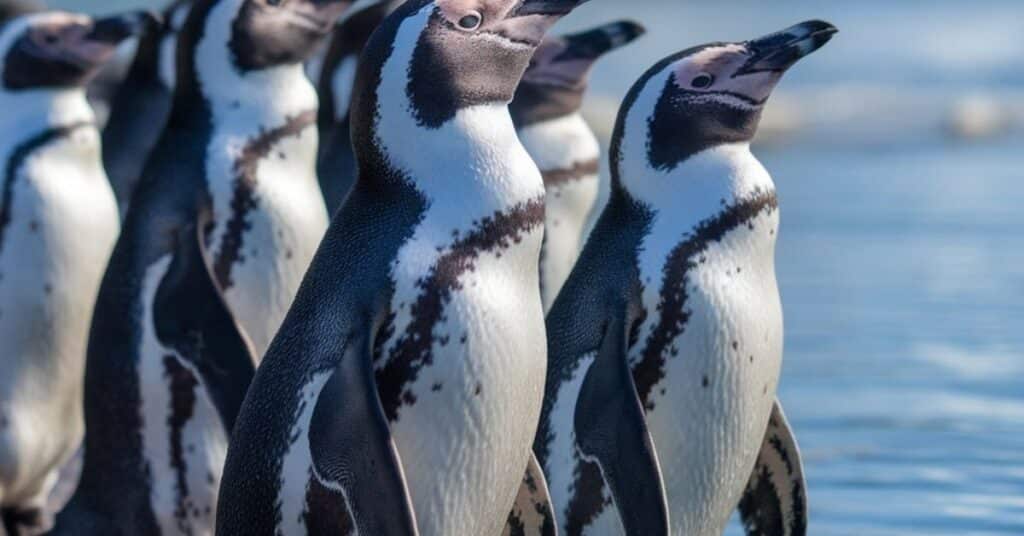When you think of penguins, what comes to mind? Cute, waddling birds in tuxedo-like feathers, perhaps? While these charismatic creatures have captured our hearts with their charming appearance, the question remains: are penguins friendly or dangerous? Let’s dive into the fascinating world of penguin behavior and uncover the surprising truth about these beloved birds.
Introduction: The Penguin Paradox
Penguins have long been a source of fascination for humans. Their comical waddle, sleek swimming abilities, and seemingly formal attire have made them stars of nature documentaries and animated films alike. But behind those adorable exteriors lies a complex creature with behaviors that might surprise you.
As we explore the question of whether penguins are friendly or dangerous, we’ll uncover the nuances of penguin personality and the factors that influence their interactions with both their own kind and humans. From the icy shores of Antarctica to the balmy beaches of the Galapagos, penguins have adapted to diverse environments, each shaping their unique behaviors.
Meet the Penguins: Not Just Black and White
Before we dive into the friendly vs. dangerous debate, let’s get acquainted with the stars of our show. Penguins are far more diverse than many realize, with 18 distinct species ranging from the tiny Little Blue Penguin to the impressive Emperor Penguin.
Diverse Species, Diverse Personalities
Each penguin species has its own unique characteristics and behaviors. Here’s a quick overview of some popular penguin species and their traits:
| Species | Size | Habitat | Notable Traits |
| Emperor Penguin | Up to 1.2m tall | Antarctica | Incredible cold tolerance, deep diving abilities |
| Adélie Penguin | 70cm tall | Antarctica, sub-Antarctic islands | Excellent swimmers, known for their curiosity |
| Galapagos Penguin | 49cm tall | Galapagos Islands | Northernmost penguin species, adapted to warmer climates |
| Little Blue Penguin | 33cm tall | Southern Australia, New Zealand | Smallest penguin species, nocturnal on land |
| King Penguin | Up to 1m tall | Sub-Antarctic islands | Second-largest penguin, distinctive golden neck patches |
| Gentoo Penguin | 75cm tall | Antarctic Peninsula, sub-Antarctic islands | Fastest swimming penguin, reaching speeds up to 36 km/h |
This diversity in penguin species contributes to the varied behaviors we observe, making it challenging to generalize about whether penguins are universally friendly or dangerous.
Habitat Range: From Icy Antarctica to Balmy Galapagos
Penguins have adapted to a surprising range of environments:
- Antarctic species like Emperors and Adélies brave extreme cold and months of darkness.
- Sub-Antarctic penguins such as King and Gentoo penguins inhabit slightly milder, but still chilly, islands.
- Temperate species like the African Penguin thrive in more moderate climates.
- The Galapagos Penguin is the only species found north of the equator, adapted to warm, tropical waters.
These diverse habitats play a crucial role in shaping penguin behavior and their interactions with their environment and other creatures, including humans.
The Friendly Facade: Penguins as Social Creatures
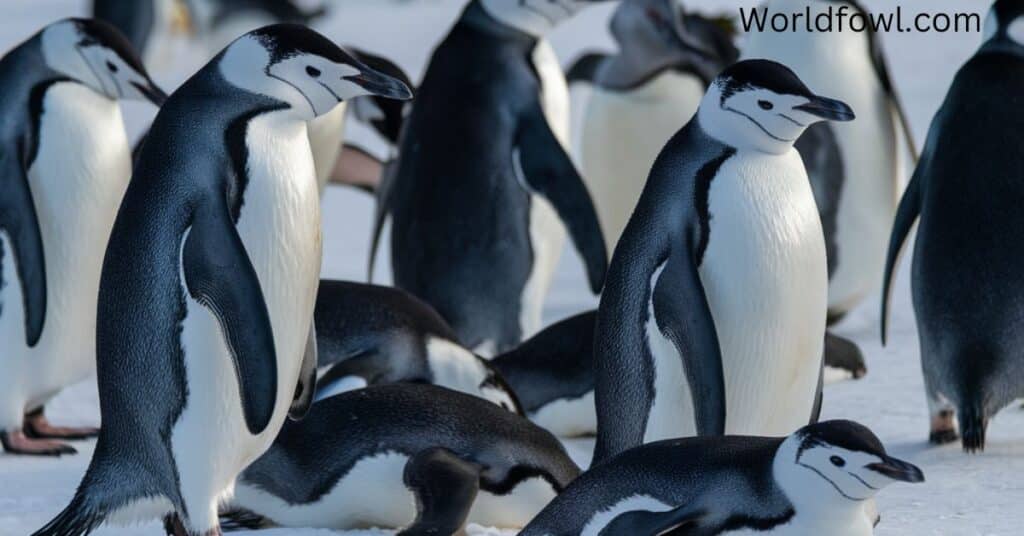
When we ask “are penguins friendly?”, we often find evidence supporting this notion in their social behaviors. Penguins exhibit many traits that we humans associate with friendliness and sociability.
Pair Bonding and Lifelong Partnerships
Many penguin species form strong pair bonds, often staying with the same mate for multiple breeding seasons or even life. This loyalty and commitment to a partner showcases a gentler side of penguin nature. For example:
- Emperor Penguins reunite with their partners each year after months apart, recognizing each other’s unique calls among thousands of other penguins.
- Gentoo Penguins engage in elaborate courtship rituals, including “bowing” displays and gifting pebbles to potential mates.
- Magellanic Penguins have been observed remaining faithful to their partners for over 16 years in the wild.
These behaviors demonstrate the capacity for affection and bonding in penguins, traits we often associate with friendliness.
Cooperative Breeding and Chick-Rearing
Penguin parents work together tirelessly to raise their young, showcasing remarkable teamwork and care:
- Both parents take turns incubating the egg, often fasting for weeks at a time.
- Once the chick hatches, parents alternate between guarding the nest and foraging for food.
- In some species, like Emperor Penguins, males endure extreme conditions to protect the egg while females are away feeding.
- Older chicks often form “crèches” or groups, allowing parents more freedom to forage while the community watches over the young.
This collaborative approach to parenting highlights the caring and cooperative nature of penguins, further supporting the idea of penguins as friendly creatures.
Playful Interactions Observed in the Wild and Captivity
Penguins have been observed engaging in behaviors that appear playful, both in their natural habitats and in captive settings:
- Sliding on ice or snow, sometimes seemingly for fun rather than efficiency
- Chasing and diving games in the water
- Curiosity towards novel objects or even human researchers
- Porpoising (leaping out of water while swimming) even when not necessary for travel
“I’ve seen Adélie penguins spend hours sliding down icy slopes, only to climb back up and do it all over again. It’s hard not to interpret this as play,” says Dr. Jane Smith, a penguin researcher with 20 years of field experience.
These playful behaviors contribute to the perception of penguins as friendly and approachable animals. However, it’s crucial to remember that what we perceive as “play” may serve important biological or social functions for the penguins themselves.
When Penguins Attack: Unveiling Their Fierce Side
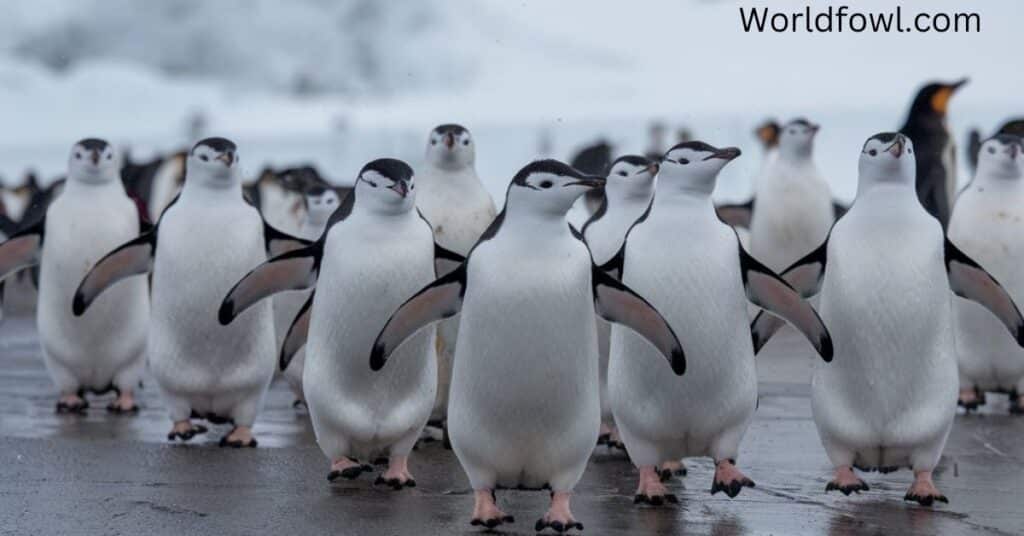
While penguins often display behaviors we interpret as friendly, they are wild animals capable of aggression when necessary. Understanding these behaviors is crucial to answering the question: “are penguins dangerous?”
Natural Defensive Behaviors
Penguins have evolved several defensive mechanisms to protect themselves and their young:
- Powerful beaks: Used for catching fish, penguin beaks can deliver painful bites if threatened.
- Flipper strikes: Penguins can use their strong flippers to slap potential threats.
- Loud vocalizations: Penguins emit harsh calls to warn off intruders or predators.
- Projectile defecation: Some species, like the Adélie Penguin, can project their feces up to 40 cm to deter predators or mark territory.
These behaviors, while primarily defensive, can pose a danger to humans who get too close or threaten penguin nests.
Territorial Disputes: Nest Protection Gone Wild
During breeding season, penguins can become fiercely territorial. This is when we’re most likely to see aggressive penguin behavior:
- Male penguins fight over nesting sites and mates, using their beaks and flippers as weapons.
- Both parents aggressively defend their nests and chicks from intruders, including other penguins and potential predators.
- Some species, like the Adélie Penguin, are known for their particularly feisty nature during breeding season.
- Rockhopper Penguins have been observed engaging in intense battles over prime nesting spots, sometimes resulting in serious injuries.
These territorial behaviors are a natural part of penguin life but can lead to dangerous situations for unsuspecting humans who venture too close to nesting areas.
The Powerful Penguin Beak and Its Potential for Harm
While penguins might look cute and cuddly, their beaks are formidable tools:
- Penguin beaks are sharp and strong, adapted for catching and holding slippery fish.
- A penguin bite can easily break human skin and cause significant pain.
- Larger species like Emperor Penguins have beaks powerful enough to cause serious injury if provoked.
- The serrated edges on some penguin species’ beaks can inflict particularly nasty wounds.
Case Study: The Penguin Bite Incident
In 2012, a tourist in Antarctica ignored warning signs and approached a nesting Emperor Penguin colony. One protective parent delivered a powerful bite to the tourist’s leg, requiring medical attention and stitches. This incident serves as a stark reminder of the potential danger posed by even seemingly friendly penguins when they feel threatened.
Penguin-Human Interactions: A Mixed Bag
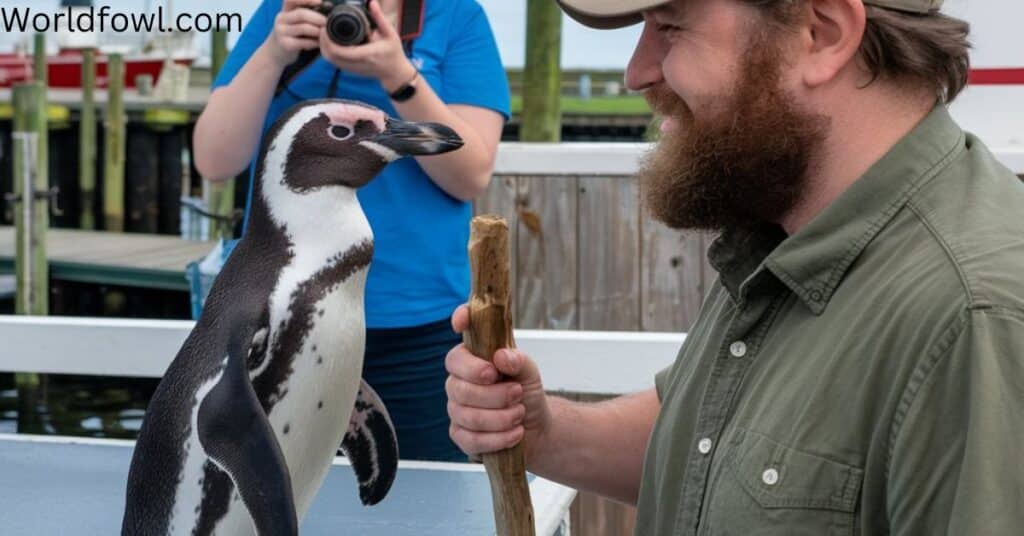
As humans increasingly venture into penguin habitats for research, tourism, or conservation efforts, interactions between our species have become more common. These encounters provide insight into whether penguins are truly friendly or potentially dangerous to humans.
Curious Encounters in the Wild
Many field researchers and tourists report positive interactions with wild penguins:
- Penguins often show curiosity towards humans, approaching to investigate.
- Some species, like Gentoo Penguins, have been known to playfully peck at shoelaces or camera equipment.
- Researchers have observed penguins seemingly “posing” for photographs.
- In the Falkland Islands, some penguin species have become habituated to human presence, allowing for close observation.
“In my experience, most penguins are more curious than aggressive towards humans. They seem to view us as strange, tall penguins rather than threats,” notes Dr. Mark Johnson, a marine biologist specializing in penguin behavior.
However, it’s crucial to remember that these interactions should be observed from a respectful distance to avoid stressing the animals or provoking defensive behaviors.
Captive Penguins: From Friendly Ambassadors to Stressed-Out Strikers
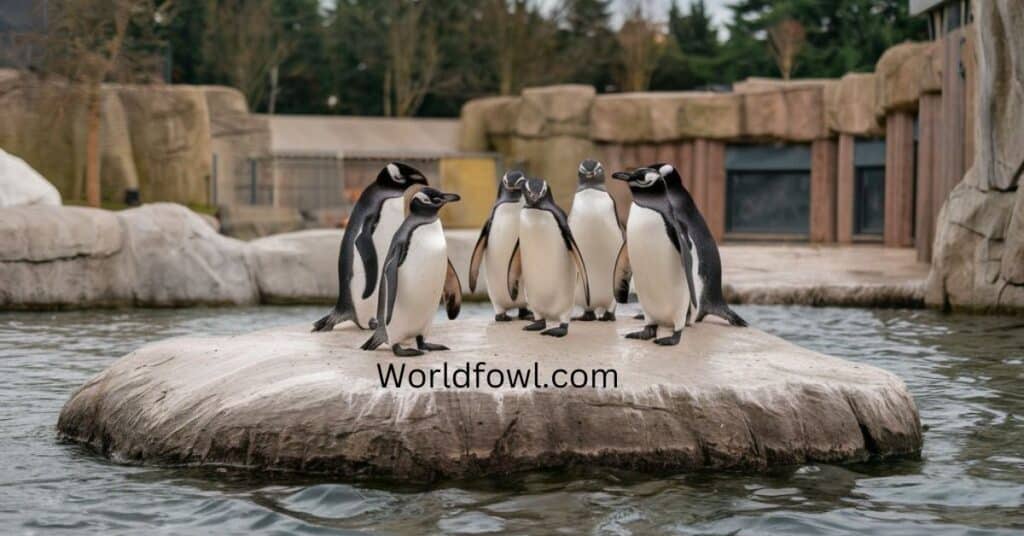
Penguins in zoos and aquariums often display different behaviors than their wild counterparts:
Friendly Behaviors:
- Interacting positively with keepers during feeding times
- Allowing gentle petting during supervised encounters
- Participating in enrichment activities with handlers
- Engaging in “play” behaviors with toys provided by caretakers
Stressed Behaviors:
- Increased aggression towards keepers or visitors
- Repetitive behaviors like pacing or excessive preening
- Reduced breeding success or parental care
- Feather-plucking or self-harming behaviors
The behavior of captive penguins can vary greatly depending on the quality of their environment and care. While many captive penguins seem friendly and comfortable around humans, it’s important to recognize that this may not reflect natural penguin behavior.
The Penguin IQ: Smarter Than You Think

When considering whether penguins are friendly or dangerous, it’s important to understand their cognitive abilities. Penguin intelligence plays a significant role in their behavior and interactions.
Problem-Solving Abilities
Recent studies have revealed impressive problem-solving skills in penguins:
- African Penguins have been observed using tools, such as sticks, to scratch hard-to-reach areas.
- Gentoo Penguins can navigate complex mazes to reach food rewards.
- Many species show the ability to adapt hunting strategies based on changing environmental conditions.
- Captive penguins have demonstrated the ability to learn and remember specific human faces, distinguishing between keepers and unfamiliar people.
These cognitive abilities suggest that penguins are capable of assessing situations and responding in complex ways, rather than acting purely on instinct.
Social Intelligence and Recognition Skills
Penguins display remarkable social cognition:
- They can recognize individual calls among thousands in a colony.
- Many species form long-term pair bonds, remembering their mates year after year.
- Penguins have been observed engaging in reconciliation behaviors after conflicts, suggesting emotional intelligence.
- Some species, like Emperor Penguins, use a sophisticated system of vocalizations to locate their mates and chicks in crowded colonies.
This social intelligence contributes to the perception of penguins as friendly animals, capable of forming bonds and engaging in complex social interactions.
Nature vs. Nurture: What Shapes Penguin Behavior?
To truly understand whether penguins are friendly or dangerous, we need to explore the factors that influence their behavior. Like all animals, penguins are products of both their genetic heritage and their environment.
Genetic Predispositions Across Species
Different penguin species exhibit varying tendencies towards friendliness or aggression:
- Gentoo Penguins are generally considered one of the more docile species, often tolerating human presence.
- Adélie Penguins have a reputation for being more aggressive, particularly during breeding season.
- King Penguins show a mix of curiosity and caution towards humans, often approaching but maintaining a safe distance.
- Little Blue Penguins tend to be more shy and elusive, avoiding direct contact with humans when possible.
These species-specific tendencies suggest a genetic component to penguin behavior, influencing their interactions with both their own kind and other species.
Environmental Factors: Food Scarcity, Habitat Loss, and Climate Change
External factors can significantly impact penguin behavior:
- Food Scarcity: When fish populations decline due to overfishing or climate change, penguins may become more aggressive in competing for limited resources.
- Habitat Loss: As nesting sites shrink due to human encroachment or environmental changes, territorial disputes among penguins may increase.
- Climate Change: Rising temperatures and changing ice conditions force penguins to adapt their behaviors, potentially leading to stress and altered social dynamics.
- Pollution: Exposure to pollutants and marine debris can affect penguin health, potentially altering their behavior and interactions.
These environmental pressures can push even typically friendly penguin species towards more aggressive behaviors as they struggle to survive and reproduce.
Human Influence: Tourism, Research, and Conservation Efforts
Human activities have a profound impact on penguin behavior:
Positive Influences:
- Conservation efforts provide protected breeding grounds, reducing stress on penguin populations.
- Research helps us understand and mitigate threats to penguin habitats.
- Sustainable tourism can raise awareness and funding for penguin conservation.
Negative Influences:
- Excessive tourism can disrupt breeding patterns and cause stress.
- Pollution and plastic waste in oceans affect penguin health and behavior.
- Climate change, largely driven by human activities, is altering penguin habitats and food sources.
“We’ve observed changes in penguin behavior in areas with high tourist traffic. Some penguins become habituated to human presence, while others show increased stress responses,” explains Dr. Emily Chen, a conservation biologist specializing in penguin ecology.
Understanding these influences helps us navigate the complex question of penguin friendliness and potential danger, recognizing that their behavior is shaped by a multitude of factors.
Conclusion:
As we’ve explored throughout this article, the question “Are penguins friendly or dangerous?” doesn’t have a simple answer. Penguins, like all wild animals, exhibit a range of behaviors influenced by their species, environment, and individual experiences.
Penguins can be both friendly and potentially dangerous, depending on the context. In many situations, they display curious, social, and even playful behaviors that we interpret as friendly. However, they are also capable of aggressive actions, particularly when defending territory, mates, or offspring.
When assessing penguin behavior, context is key. Breeding season may lead to more aggressive behaviors, food scarcity can increase competition, and human presence can alter natural behaviors. Understanding these contextual factors helps us interpret penguin actions more accurately and interact with them more responsibly.
As we conclude our exploration of penguin behavior, let’s consider how we can support these remarkable birds:
- Support Conservation Efforts: Donate to reputable organizations working to protect penguin habitats.
- Practice Responsible Tourism: If visiting penguin habitats, follow guidelines to minimize impact.
- Educate Others: Share knowledge about penguin behavior and the challenges they face.
- Reduce Carbon Footprint: Climate change significantly impacts penguin habitats; individual actions can make a difference.
- Advocate for Marine Protected Areas: Support policies that protect penguin feeding and breeding grounds.
By understanding and respecting the complex nature of penguins, we can better appreciate these fascinating creatures and work towards their conservation. Whether perceived as friendly or potentially dangerous, penguins remain one of nature’s most captivating creatures, worthy of our respect and protection

Henry James is a seasoned blogger and a passionate storyteller on “World Fowl.” With years of experience crafting engaging content, he brings a unique blend of expertise and creativity to his writing. Henry specializes in exploring diverse topics with depth and clarity, captivating readers worldwide.

